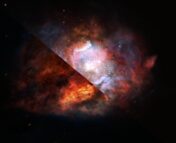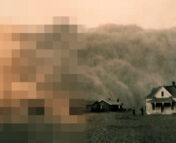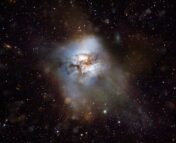Authors: Xuejian Shen, Mark Vogelsberger, Dylan Nelson, Sandro Tacchella, Lars Hernquist, Volker Springel, Federico Marinacci, Paul Torrey
First Author’s Institution: TAPIR, California Institute of Technology, Pasadena, CA
Status: Published in MNRAS [closed access]
When we look out into distant space, at galaxies we’ve never seen before, what will we see? This is what today’s authors set out to do, with the goal of predicting what upcoming JWST surveys (now more upcoming than ever, after the successful launch!) will reveal about the dusty parts of the distant Universe.
A universe in a petri dish
How do astronomers predict something we’ve never seen before? We can’t exactly make galaxies in a petri dish to experiment on, so instead we put our best physical models into powerful computers and simulate a Universe to examine in detail.
However, these cosmological simulations are not perfect renditions of the Universe: they are limited both by computing power and by our understanding of the physics involved. For example, usually large simulations have some limiting resolution, where we can resolve individual galaxies but not individual stars or clumps of dust and gas within those galaxies. In order to calibrate our imperfect best models, we test the modeled Universe against our observed Universe. In this way, we use simulations to make comparisons backwards (from simulations to existing observations, to test the physical models) and forwards (from simulations to future observations to predict what we might observe and its significance to our understanding of the Universe).
Today’s authors take one such cosmological simulation, IllustrisTNG, and examine its model Universe in the context of future JWST surveys. To turn the simulation into mock observed data, they process the simulation results using radiative transfer calculations, which traces emitted light and its processes like absorption and scattering as it travels through a medium, like gas and dust. This allows them to predict properties of the simulated galaxies as we would observe them.
JWST: not the next Hubble
Most of our observations so far with large samples of distant galaxies cover the unobscured starlight seen at shorter wavelengths, using telescopes like Hubble Space Telescope. Even with these rich datasets from Hubble, we’re missing a big piece of the puzzle, since many actively star-forming galaxies are rich with dust that obscures the shorter wavelength light emitted directly from the newly formed stars. By also observing in the longer, infrared range, we can expand our catalogs to include obscured galaxies detected through their star-heated dust emission.
To this point, looking ahead to JWST, while it is the next big thing in terms of space telescopes, importantly it’s not exactly the next Hubble. While Hubble covers primarily ultraviolet and optical wavelengths, JWST operates in the near and mid infrared, making it ideal for advancing our understanding of high redshift galaxies, including the dusty ones. Characterizing the obscured galaxy population is key for honing our models of galaxy and star formation, as dusty star-forming galaxies dominate star formation activity at its cosmic peak. With this in mind, today’s authors focus on long wavelength emission from distant galaxies at redshifts z≥4, or in the first 2 billion years of the Universe.
The trouble with dust
Simulating dust can be tricky: beyond the scattering and absorption processes of dust grains, dust in galaxies is often clumpy and holey, making it difficult to model robustly. The base cosmological simulation doesn’t include such complicated, precise calculations of dust emission in galaxies. In today’s paper, the authors take the simulation a step further by adding radiative transfer physics to its modeled distant galaxies to make precise predictions of the dust emission. With these processed galaxies, the authors constructed spectral energy distributions (see Figure 1) for each of them – the observed light emitted from the galaxy spanning wavelengths – and derived characteristics of the population.
To test if their simulations and proceeding calculations were sound, they compared their results to existing infrared observations. Overall, they found good consistency with basic observed properties like the abundance of galaxies detected at a given brightness, or the luminosity function in certain bands. Yet, one discrepancy arose: their simulated population had significantly fewer dusty star-forming galaxies, a class of intrinsically luminous and highly dust-obscured, massive starbursting galaxies. This discrepancy has been noted before in other theoretical studies, and both theoretically and observationally, the abundance of these dusty starbursts at early times is still somewhat unconstrained. As these galaxies are among the most luminous and actively star-forming galaxies, their abundance has implications for how massive galaxies form and evolve as well as the history of star formation in the Universe. Further, comparing theoretical predictions like this one to real observations with JWST will help refine the physics input into the simulations, especially regarding complex feedback processes.
Making predictions
The authors predict the number of galaxies we’ll detect with using JWST, reporting that at redshift z = 6 they expect to detect hundreds to thousands of galaxies in wide surveys, depending on the specific infrared band. With multiple legacy surveys already on the docket for the current cycle, theoretical predictions like those in this paper assure us that we’ll have large enough samples of distant galaxies to piece together some of their unsolved mysteries. And with these upcoming infrared observations, we’ll begin to disentangle the outstanding discrepancies about the role of dust-obscured galaxies in the first few billion years of the Universe.
Astrobite edited by Graham Doskoch
Featured image credit: adapted from IllustrisTNG and Getty Images/iStock




